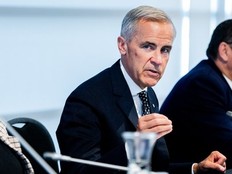GOLDSTEIN: Prepare for more billion-dollar boondoggles
Reports by financial watchdogs of government spending suggest there are major concerns about how public infrastructure projects will be approved

Article content
What happens when Prime Minister Mark Carney’s promise of massive new federal spending on public infrastructure and speedy approval of “nation building projects” runs into the fact the federal public service routinely ignores the rules for spending public money and approving such projects?
The answer, potentially, is the waste of mega-billions of public dollars on projects that are so poorly administered, some may never be completed.
The issue isn’t the policies themselves.
Carney’s Liberals and the official opposition Conservatives agree with streamlining the process for green-lighting projects such as pipelines, mines and other forms of energy infrastructure, if they are endorsed by the province and Indigenous groups where they occur.
That was evidenced by their rapid approval of Bill C-5, the One Canadian Economy Act on Friday, before Parliament adjourned for the summer.
Liberals and Conservatives passed the legislation intended to boost the Canadian economy given the damage caused by President Donald Trump’s tariff war and the fact the U.S. is no longer a reliable trading partner or ally of Canada.
The legislation is now headed to the Senate, scheduled to sit until June 27, for final approval before Canada Day on July 1.
But recent reports by Parliament’s two financial watchdogs of government spending – Auditor General Karen Hogan and Parliamentary Budget Officer Yves Giroux – suggest there are major concerns about how these projects will be approved.
Hogan reviewed the Liberal government’s approval of the notorious ArriveCan app that was supposed to cost $80,000 and ended up costing about $60 million, as well as 106 other professional services contracts awarded by 31 federal departments and agencies and one Crown corporation to IT staffing firm GCStrategies Inc. from 2015 to 2024.
They totalled up to $92.7 million – of which, $64.5 million was paid out.
Hogan found a widespread failure within the federal public service to follow the rules in awarding these contacts intended to ensure taxpayers get good value for money.
She said the same thing happened when she examined 97 contracts awarded by 20 federal departments agencies and Crown corporations valued at $209 million, with $200 million paid out, to management consulting firm McKinsey & Company, from 2011 to 2023.
“I said it back then and I’ll repeat it now – I have no reason to believe this is unique to two vendors and that’s why I believe the government needs to take a step back and look at why this is happening,” Hogan warned.
Hogan took the unusual step of not making any recommendations on her findings, saying the problem isn’t a lack of rules but the federal bureaucracy ignoring them.
RECOMMENDED VIDEO
In a separate report, Hogan estimated the cost of replacing Canada’s aging fleet of CF-18 fighter jets with 88 new F-35s, increased by almost 50% within two years – from $19 billion in 2022 to $27.7 billion in 2024.
In addition, another $5.5 billion will be needed for infrastructure needed to make the new jet fighters fully operational, because the government relied on outdated data and failed to develop contingency plans for managing financial risks associated with the project.
She also noted a long-standing shortage of trained fighter pilots.
In a report released Thursday, parliamentary budget officer Yves Giroux said because Carney has delayed the federal budget until fall, he can’t determine whether his claim he will balance the federal operating budget by 2028-29 is credible.
Nor can he determine whether Carney will achieve his commitment to increase federal spending on defence to the NATO target of 2% of GDP this fiscal year, and whether the government’s overall financial plan is fiscally sustainable.
In his election platform Carney’s outlined $130 billion in new spending over four years with total deficit spending of $224.8 billion. That’s 71% higher than the $131.4 billion in deficit spending the Trudeau government predicted during the same period last December.
The problem, Giroux said, is that Carney is claiming he can balance the operating budget, the cost of running the government, within three years, while financing new capital spending on infrastructure with more public debt.
“There is no commonly accepted definition of what is defined as ‘operating’ or ‘non-operating capital’ spending,” Giroux wrote, meaning he “is unable to assess whether the government’s recent policy initiatives presented in Parliament … are consistent with achieving its new fiscal objective … This means the government could achieve its fiscal objective and yet be fiscally unsustainable.”
Unless the federal government addresses the concerns of the auditor general and parliamentary budget officer, expect for more billion-dollar boondoggles of the type we’ve seen so often in the past.














Postmedia is committed to maintaining a lively but civil forum for discussion. Please keep comments relevant and respectful. Comments may take up to an hour to appear on the site. You will receive an email if there is a reply to your comment, an update to a thread you follow or if a user you follow comments. Visit our Community Guidelines for more information.